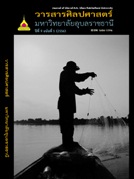ตัวนำส่วนเติมเต็มในภาษาไทยถิ่นอีสาน
Main Article Content
บทคัดย่อ
ตัวนำส่วนเติมเต็มมีบทบาทอย่างมากในประโยคความซ้อน ตัวนำส่วนเติมเต็มในภาษาไทยถิ่นกลางที่นักภาษาศาสตร์ได้ศึกษาไว้ได้แก่ ว่า ให้ ที่ จากการค้นคว้ายังไม่พบว่ามีการศึกษาตัวนำส่วนเติมเต็มในภาษาไทยถิ่น ผู้เขียนสันนิษฐานว่า การปรากฏของตัวนำส่วนเติมเต็มในภาษาไทยถิ่นน่าจะมีความแตกต่างไปจากภาษาไทยถิ่นกลาง บทความนี้มีวัตถุประสงค์ที่จะค้นหาตัวนำส่วนเติมเต็มในภาษาไทยถิ่นอีสานว่ามีคำใดบ้าง มีการปรากฏแตกต่างไปจากภาษาไทยถิ่นกลางอย่างไร และตัวนำส่วนเติมเต็มเหล่านั้นมีการปรากฏร่วมกับคำกริยาประเภทใด ผู้เขียนเก็บข้อมูลประโยคในภาษาไทยถิ่นอีสานเพื่อนำมาเปรียบเทียบกับประโยคในภาษาไทยถิ่นกลาง โดยเก็บจากเอกสารภาษาไทยถิ่นกลาง และภาษาไทยถิ่นอีสานที่พิมพ์ด้วยอักษรไทย จากนั้นนำไปสอบถามผู้บอกภาษาอีสาน ผลการศึกษาพบว่า คำกริยา ว่า ให้ ในภาษาถิ่นอีสานมีการกลายเป็นคำไวยากรณ์ โดยมีหน้าที่เป็นตัวนำส่วนเติมเต็มเช่นเดียวกันกับในภาษาไทยถิ่นกลาง การปรากฏของตัวนำ ส่วนเติมเต็ม ว่า ให้ อาจปรากฏหลังสกรรมกริยาหรืออกรรมกริยา แต่คำกริยาในภาษาไทยถิ่นอีสานที่ปรากฏร่วมกับว่า ให้ นั้นมีจำนวนจำกัดกว่าคำกริยาที่ปรากฏร่วมในภาษาไทยถิ่นกลางอย่างไรก็ตามบางประโยคสามารถละตัวนำส่วนเติมเต็ม ให้ ว่า และมีการหยุดชั่วขณะหน้าอนุพากย์ซ้อน ส่วนคำนาม หม่อง หรือ บ่อน (ที่) ในภาษาไทยถิ่นอีสานไม่ปรากฏเป็นตัวนำส่วนเติมเต็มอย่างในภาษาไทยถิ่นกลาง การปรากฏของตัวนำส่วนเติมเต็ม ที่ ในภาษาไทยถิ่นกลางซึ่งไม่ปรากฏในภาษาไทยถิ่นอีสานนั้นผู้บอกภาษาจะพูดเป็นประโยคความเดียวสองประโยค โดยไม่มีการปรากฏร่วมของตัวนำส่วนเติมเต็ม ดังนั้นคำ หม่อง หรือ บ่อน (ที่) ในภาษาไทยถิ่นอีสานซึ่งทำหน้าที่เป็นคำนาม และคำบุพบทนั้นไม่ปรากฏเป็นตัวนำส่วนเติมเต็มในภาษาไทยถิ่นอีสาน
Complementizers in Northeastern Thai dialect
The complementizers play the important role in forming complex sentence. Thai linguists had studied the complementizers in Standard Thai (ST), the finding show that there are three complementizers : ,
and
. The reviewing of literature shows that there have been no study on complementizers in Thai Dialects. I surmise that the phenomenon of complementizers in Northeastern Thai Dialects (NTD) are difference from in ST. This study aims to identify the complementizers in NTD and find out how they occur. Base on the data, forming complex sentence in NTD and ST, they were compared and found out their occurrence: verb classes and complementizers. The finding of this study, two complementizers in NTD,
and
are grammaticalized from the verb
‘to say’ and the verb
‘to give’ respectively. Their syntactic behaviors comform with the complementizers found in ST. The two complementizers in NTD may be occur back of intransitive verbs or transitive verbs, but the number of verb classes in NTD which occur with them have less than the number of verb classes in ST. However, some sentences, the Complementizers ‘
,
’ were not occurrence by the deletion (Zero Complementizers) and a pause before subordinate clauses. No have the occurrence of noun
‘place’ in NTD, the informants use the noun ‘’ or ‘’. And no have The complementizer ‘
’ in forming complex sentence in NTD, the informants will use in forming two single sentences, no have the occurrence of the Complementizers. So that the noun and the preposition ‘’ or ‘’ are not the Complementizers in NTD.


